| Page last updated
31 May 2006 |
What's New with the MUSSELp?
The highlights of 2005.
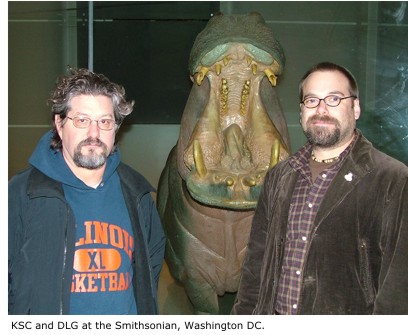 12-16 December 2005. — More Photography at the United States National Museum. The November trip to the Smithsonian only managed to capture a portion of the collection in which we were interested: the primary types and the African specimens. This second, week-long trip dwelt upon specimens from South America and Australia. Between 12 and 16 December, we captured data and images from over 1000 specimen lots — that does not include all the types! 12-16 December 2005. — More Photography at the United States National Museum. The November trip to the Smithsonian only managed to capture a portion of the collection in which we were interested: the primary types and the African specimens. This second, week-long trip dwelt upon specimens from South America and Australia. Between 12 and 16 December, we captured data and images from over 1000 specimen lots — that does not include all the types!
As with the cache of images accumulated during other museum visits, those from the Smithsonian will be sent off to our MUSSELp volunteer, Jerry Graf, to be cropped and renamed. Then, they will be uploaded into the database and attached to their associated data. It is a time consuming and labor-intensive process, the utility of the MUSSELp database to basic taxonomic research is well worth the effort!
|
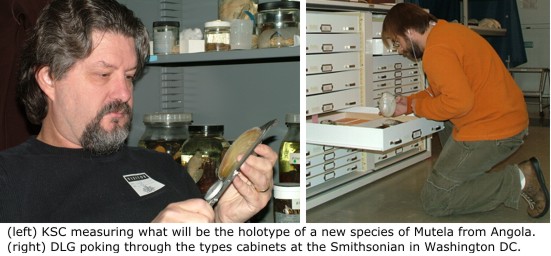
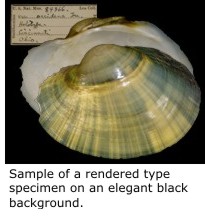 10-18 November 2005. — Writing and Photographing at the Academy of Natural Sciences and the Smithsonian National Museum of Natural History. Taking a departure from the exotic, the MUSSELp caught up on some of our backlog of "local" work. 10-18 November 2005. — Writing and Photographing at the Academy of Natural Sciences and the Smithsonian National Museum of Natural History. Taking a departure from the exotic, the MUSSELp caught up on some of our backlog of "local" work.
KSC came out to the ANS in Philadelphia to finish up the last bits of a paper describing a new species of Mutela from the Cuanza River in southwestern Africa. That paper, intended for publication in the Proceedings of the Academy of Natural Sciences, also illustrates and provides distributional records for the 22 other species that occur in the area that we refer to as the "Angola Region." The manuscript should be ready for submission after the Thanksgiving break.
After a couple days at the ASNP, the program switched venues to shoot freshwater mussels types at the Smithsonian in Washington DC. To date, all of the USNM's Africa specimens have been digitally imaged as well. Mussel records from Australia, South and Central America await our next trip the the capital city.
When shooting type specimens, we follow a different procedure than we do for general specimen records. The latter are shot on a gray background, with an aim at capturing as much data as possible in a time efficient manner — quantity is given priority over quality. For types, the emphasis is on getting a nice picture. The two valves are shot separately on black velvet. Click here to get a closer look at one of our type images. Work at the Smithsonian was spent capturing images. It will likely be weeks (or months) before all of the original jpegs have been rendered and uploaded to the MUSSELpdb.
|
7 September 2005. — ANSP's Dr. Mark Sabaj Collects Freshwater Mussels in Peru. In 2003, Dr. Mark Sabaj, Collection Manager of Ichthyology at the ANSP, traveled to Iquitos, Peru to collect mussels on behalf of the MUSSELp. On that trip, he was largely skunked.
But, over the course of a couple weeks in August 2005, Dr. Sabaj came through with a diverse haul of mussels representing two families from the Rio Itaya. These he donated to the MUSSEL Project, to be split between the Academy of Natural Sciences and the Illinois Natural History Survey. This material will be extremely valuable for our work to revise the Hyriidae and Mycetopodidae. Thanks, Mark!
Click here to learn more about Dr. Sabaj's musseling efforts in Peru.
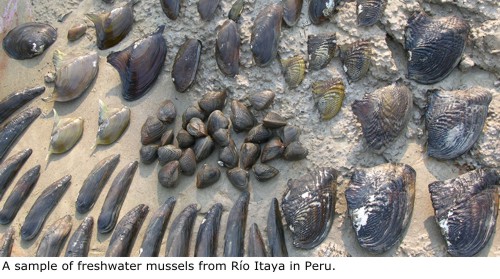
10 July-2 August 2005. — Proposal Development and Freshwater Sampling in London, UK and eastern Zambia. Our objectives in the United Kingdom and Zambia were varied, but they all contributed to a single project: to assess the feasibility of building a research program in Zambia that could involve students. We are pleased to announce that the trip was a success! Zambia is an interersting place to undertake molluscan research, and it would be a great environment for beginning biologists to cut their teeth on field research.
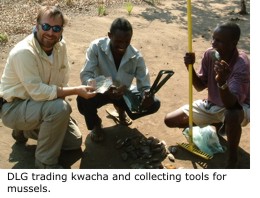 From 10-14 July, DLG and Dr. Alec Lindsay (Northern Michigan University) investigated various aspects of the history of African exploration in London and the surrounding countryside. Included among the visited sites was the Royal Geographical Society, which expressed in interest in our proposed project to bring students to London to gain a perspective of the Western view of the colonization of Africa. DLG also visited the Natural History Museum in Kensington to follow up on some discoveries made during the MUSSELp London expedition last fall. From 10-14 July, DLG and Dr. Alec Lindsay (Northern Michigan University) investigated various aspects of the history of African exploration in London and the surrounding countryside. Included among the visited sites was the Royal Geographical Society, which expressed in interest in our proposed project to bring students to London to gain a perspective of the Western view of the colonization of Africa. DLG also visited the Natural History Museum in Kensington to follow up on some discoveries made during the MUSSELp London expedition last fall.
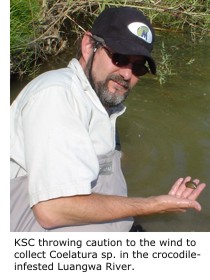 From London, our Corps of Discovery turned to Zambia, where DLG and Dr. Lindsay were joined by KSC, Jerry Graf, Dan Otte (both of the ANSP), and Bill & Else Cade (Lethbridge University, Canada). Over the course of 17 days, we collected mollusks at eight widely separated sites in eastern Zambia; at five sites we found freshwater mussels. The mollusks are still being sorted, identified and catalogued. We sampled in the Zambezi and Luangwa basins (Indian Ocean), as well as Lake Bangweulu (Atlantic Ocean via the Congo). From London, our Corps of Discovery turned to Zambia, where DLG and Dr. Lindsay were joined by KSC, Jerry Graf, Dan Otte (both of the ANSP), and Bill & Else Cade (Lethbridge University, Canada). Over the course of 17 days, we collected mollusks at eight widely separated sites in eastern Zambia; at five sites we found freshwater mussels. The mollusks are still being sorted, identified and catalogued. We sampled in the Zambezi and Luangwa basins (Indian Ocean), as well as Lake Bangweulu (Atlantic Ocean via the Congo).
Over the course of our adventure, we met with marauding wildlife, hot days, cold nights, an annoying lack of water and a diesel shortage that seriously threatened our mobility. But the mission went well, and we look forward to returning to Central Africa. We owe special thanks to the following for their help with this trip:
- Alex Chilala, Fisheries Research Officer in Zambia, provided administrative support, including acquiring the necessary permissions.
- Dan Otte of the Academy of Natural Sciences has decades of experience working in Africa and served as our guide.
- Jerry Graf, ANSP Volunteer, provided logistical support for the group, including first aid and improvized automobile repair.
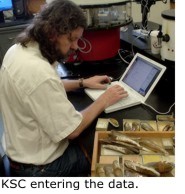 18-23 April 2005. — Trip to the Big Apple to Examine Specimens in the American Museum of Natural History. For the first collections excursion of 2005, KSC and DLG traveled to New York City, NY to study the shells at the AMNH. We acquired over 500 records and pictures for freshwater mussels from South and Central America, Africa, and Australia. 18-23 April 2005. — Trip to the Big Apple to Examine Specimens in the American Museum of Natural History. For the first collections excursion of 2005, KSC and DLG traveled to New York City, NY to study the shells at the AMNH. We acquired over 500 records and pictures for freshwater mussels from South and Central America, Africa, and Australia.
With the addition of these American Museum specimens, our database now contains over 7600 specimen records covering the entire world, but emphasizing those of the southern continents. We took the opportunity of being in the same city to improve the functionality of the MUSSELp Database to handle the management of so many records and their associated images. |
|